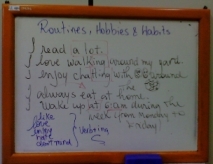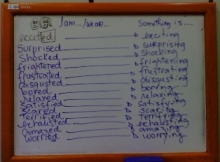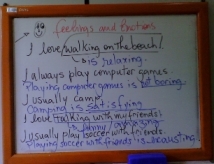I have always thought that every time we step into the classroom many things happens/can happen, much more goes on than just people learning words, sentences, grammar, etc. But I was not able to verbalize it until I met Juan Uribe. He does it perfectly in his blog and through his blog and chatting with him, I have been learning about the affective domain and its implication for language learning. In this post, Juan Uribe explains beautifully what Affective teaching is.
Providing learning opportunities in March for my Teens (9th graders) through songs, vídeos, Images and stories that promote reactions and descriptive language development as well as reflecting on our reality and other cultures. A Day in the Life of Amar – Thanks to Kieran for such wonderful lesson ideas with this video. I am using the video of Amar right now with my mixed-ability group of 9th graders (from total beginners to A2 level, group size from 1-8 students). I have adapted the suggestions as follow.
Materials & Activities:
Feelings & Emotions worksheet (it can be presented and practiced in a number of ways – I used a worksheet with facial expressions in a format of quiz. Get the right option. Allowed students to look up in a dictionary or talk to each other, then corrected and asked them to play in pairs a memory game using the images on the worksheet and eliciting from each other the right feeling/emotion.)
 My main focus is to develop descriptive language with my students this bimester while tackling different aspects of the curriculum and adding new curriculum itens like cultural aspects and investigating reality (critical thinking about life locally and globally). I gave them some examples on my own. And then on their notebooks they wrote some examples about them.
My main focus is to develop descriptive language with my students this bimester while tackling different aspects of the curriculum and adding new curriculum itens like cultural aspects and investigating reality (critical thinking about life locally and globally). I gave them some examples on my own. And then on their notebooks they wrote some examples about them.
 Then, from the Feelings & Emotions worksheet, I drew their attention on the ones with -ed endings and we changed the endings to -ing. Once they got the list of words on their notebooks, I elicited the activities I do and shared with them earlier. And on the board, I will share what I feel about them.
Then, from the Feelings & Emotions worksheet, I drew their attention on the ones with -ed endings and we changed the endings to -ing. Once they got the list of words on their notebooks, I elicited the activities I do and shared with them earlier. And on the board, I will share what I feel about them.
 As I share how I feel and elicit how they feel about those activities themselves, I hope we are creating a learning opportunity, not just to learn about the language, but also to learn about each other as we express our sentiments, ideas and thoughts without judging each other on the choices and preferences we have towards a number of things in our life. In fact, the silence should be the best place for us to reflect and assess ourselves.
As I share how I feel and elicit how they feel about those activities themselves, I hope we are creating a learning opportunity, not just to learn about the language, but also to learn about each other as we express our sentiments, ideas and thoughts without judging each other on the choices and preferences we have towards a number of things in our life. In fact, the silence should be the best place for us to reflect and assess ourselves.
Talking about our Routine is usually boring, but saying how we feel about them is not!
Now the reason why I chose the video about Amar is because I want to give them also the opportunity to think of cultures, life styles and reflect on those differences critically considering also, that it may not be part of their reality, but it is the reality of tons of children around the world, including in Brazil. Maybe even near them.
So, after we worked on the board and registered it all on their notebook. I showed the video (around 9 minutes) and the impact of it on them was really surprising. For the whole 9 minutes, their eyes didn’t blink, it lead itself to the following question:
If you could interview Amar, what questions would you ask?

Rose, I love this idea and the video! I just sat down to plan some after school class and thought we’d look at teen problems/life this week and then I saw your post. It fits perfectly with what I want to do! Once again we are on exactly the same wave length!! I hope my students are as interested in the video as yours were.
Thanks for the great idea.
LikeLike
I’m so happy to hear that Gemma. The video is really great and leaves so much space to explore in a variety of ways and level of English. I can’t thank Kieran enough for posting this video and a lesson planning on his site http://www.film-english.com. I didn’t mention in the post, but it was last Sunday night after participating in Bonny Norton’s webinar that I found the video lesson. It was so interesting because one of the things that Dr. Norton said was about using journal with students to investigate their reality would be useful way to promote language learning, empowering students and reflecting on their identities as language learners as well. I can’t wait to watch the webinar again. I am so interested in her line of research.
LikeLike
Dear Rose,
Thank you for your kind words about my work. I’m very happy that you have been able to notice and reflect more about affect in your classes after we have met. Affective Language Learning is indeed a fascinating field and I just love reading, writing, listening, and talking about it!
I didn’t blink either while I watched Amar live his routine. I hope he gets all the achievements he hopes for, as he is such a hard working boy. Watching this movie is really an eye opener for all of us to value what we might take for granted.
I like the twist you gave to talking about one’s routine with your ed/ing activity. Students probably have realized that some people might actually enjoy what they do not. But my curious thoughts are now on what your students said after they watched the movie. Did they have words to talk about it? Were they able to use the ed/ing descriptors?
I would ask young Amar the following question: What do you like the most in your routine?
Send you a big hug,
Juan
LikeLike
Thanks for the wonderful reply Juan.
I have already printed out key scenes on posters to publish around the room and this week they will work on speculating, describing and reacting to Amar’s routine. I intend to start with them speculating and using modals of deduction to express what they think Amar is feeling in the different scenes. I also made sure that the time was clear on the pictures I’ll provide them.
I’ll post soon how this week classes go. 🙂
LikeLike
Hi Rose,
Thanks for your kind words about my lesson. I really love the way you’ve adapted the lesson and material. I’m sure your students loved it too. I really like the way you reflect on your teaching and your students’ learning.
Keep up the great work!
Kieran
LikeLike
I’m glad you liked how I adapted it. Thanks so much for your support.
The video produces a sort of shocking reaction as Amar’s lifestyle is very different from theirs. But I can say that it has touched most of them in a way or the other. When I can’t wait to get all their questions and find someone to work with us in a mini-project that aims to share each others culture, and give my kids the opportunity to think further about things that matter. I’m still working on that though. They are excited about connecting with students from other places.
🙂 Thanks again for stopping by and commenting.
LikeLike
Hi Rose and many thanks for this great post. I think we need this kind of inspiring posts 🙂
LikeLike
Hi Aysun,
Thanks for the stopping by and commenting. I’m glad you liked it.
One of my biggest challenge with my groups of 9th graders (although they are not a big group – maximum number per group 10) is to create activities that are open enough for everyone to have a say because of the different levels of English while making it interesting enough to engage them in the practice of English.
You all continuously inspire me so much. Thank YOU. 🙂
And by writing here, making sense of what I am doing and getting feedbacks & questions, help me even more.
LikeLike
Hello Rose!
What I loved most about this is that through these language lessons you are helping your students connect more with themselves and each other:
“I hope we are creating a learning opportunity, not just to learn about the language, but also to learn about each other as we express our sentiments, ideas and thoughts without judging each other on the choices and preferences we have towards a number of things in our life.”
By providing this language, and the context you are embedding it in, you are helping to empower your students. You are giving them emotional literacy. You are letting them know that it’s ok to feel what they feel.
The world needs more teachers like you. I’m grateful you are out there spreading understanding a love.
Love and light,
Josette
LikeLike
Thanks Josette for all that you have said. You have actually put into words on how I feel about this. Emotional literacy, this is the first time I have heard it. Much have been said that engaging students with English through activities that they like (games, movies, songs) foster motivation to learn, but they have become just an excuse to make the language (students find boring – talking about the present, the past, the future, to name a few grammar content) more interesting to the students however it is still meaningless for them. What I have noticed though is what may engage them naturally to use language is to give them the tools they need to communicate what they think and feel. It is very superficial to ask students to practice the language without any real purpose, but sharing personal stories and opinions is not superficial though because it is media on a daily basis we use to connect to people in any situation or place, by sharing about ourselves. I also realized that non-native speakers have some difficult expressing ourselves when comes to use descriptive language. I thought that can really add meaning to the communication in class. The feedback students gave the past week was very positive about learning on how to express feelings and emotions.
LikeLike
I found this video quite interesting on how important is descriptive language. Simple and effective.
LikeLike
Pingback: Reflecting on Learners Engagement during the 1st month of classes | ROSE BARD – Teaching Journal